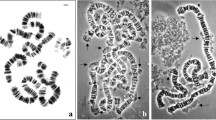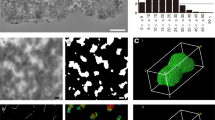Abstract
IN examining buccal smears for sex chromatin, one finds a surprisingly high incidence of sex chromatin bodies not merely at the nuclear membrane but also more precisely at the periphery of what appears to be a disk-shaped nucleus. The following discussion will provide evidence that, as in tissue cultures1, the sex chromatin is characteristically at the edge of the nuclear disk in squamous cells in vivo. In establishing this let us first consider that squamous nuclei in vivo are flattened. This may be seen in mucosal smears when a mucosal fragment is folded over (Fig. 1). It is evident, too, that the cells in fragments in the smear maintain the same relative position to one another that they had in vivo, and that one is seeing the cells as one would have seen them in looking directly down on to the mucosal surface. Further, in most nuclei which can be reliably scored, one can visualize all, or almost all, the nucleoplasm by focusing up and down. Thus one can visualize the sex chromatin regardless of its position in the nucleus.
This is a preview of subscription content, access via your institution
Access options
Subscribe to this journal
Receive 51 print issues and online access
$199.00 per year
only $3.90 per issue
Buy this article
- Purchase on Springer Link
- Instant access to full article PDF
Prices may be subject to local taxes which are calculated during checkout
Similar content being viewed by others
References
Miles, C. P., Cancer, 12, 299 (1959).
Prince, R. H., Graham, M. A., and Barr, M. L., Anat. Rec., 122, 153 (1955).
Klinger, H. P., and Ludwig, K. S., Stain Technol., 32, 235 (1957).
Castro, N. M. de, and Sasso, W. da S., An. Pac. farmacia Odont. S. Paulo, 11, 249 (1953). Moore, K. L., and Barr, M. L., Acta Anat., Basel, 21, 197 (1954). Hungerford, D. A., Donnelly, A. J., Nowell, P. C., and Beck, S., Amer. J. Human Genet., 11, 215 (1959).
Author information
Authors and Affiliations
Rights and permissions
About this article
Cite this article
MILES, C. Peripheral Position of Sex Chromatin. Nature 191, 626–627 (1961). https://doi.org/10.1038/191626b0
Issue Date:
DOI: https://doi.org/10.1038/191626b0
This article is cited by
-
Studies on the location of the Y fluorescent body in human interphase nuclei
Human Genetics (1974)
Comments
By submitting a comment you agree to abide by our Terms and Community Guidelines. If you find something abusive or that does not comply with our terms or guidelines please flag it as inappropriate.



